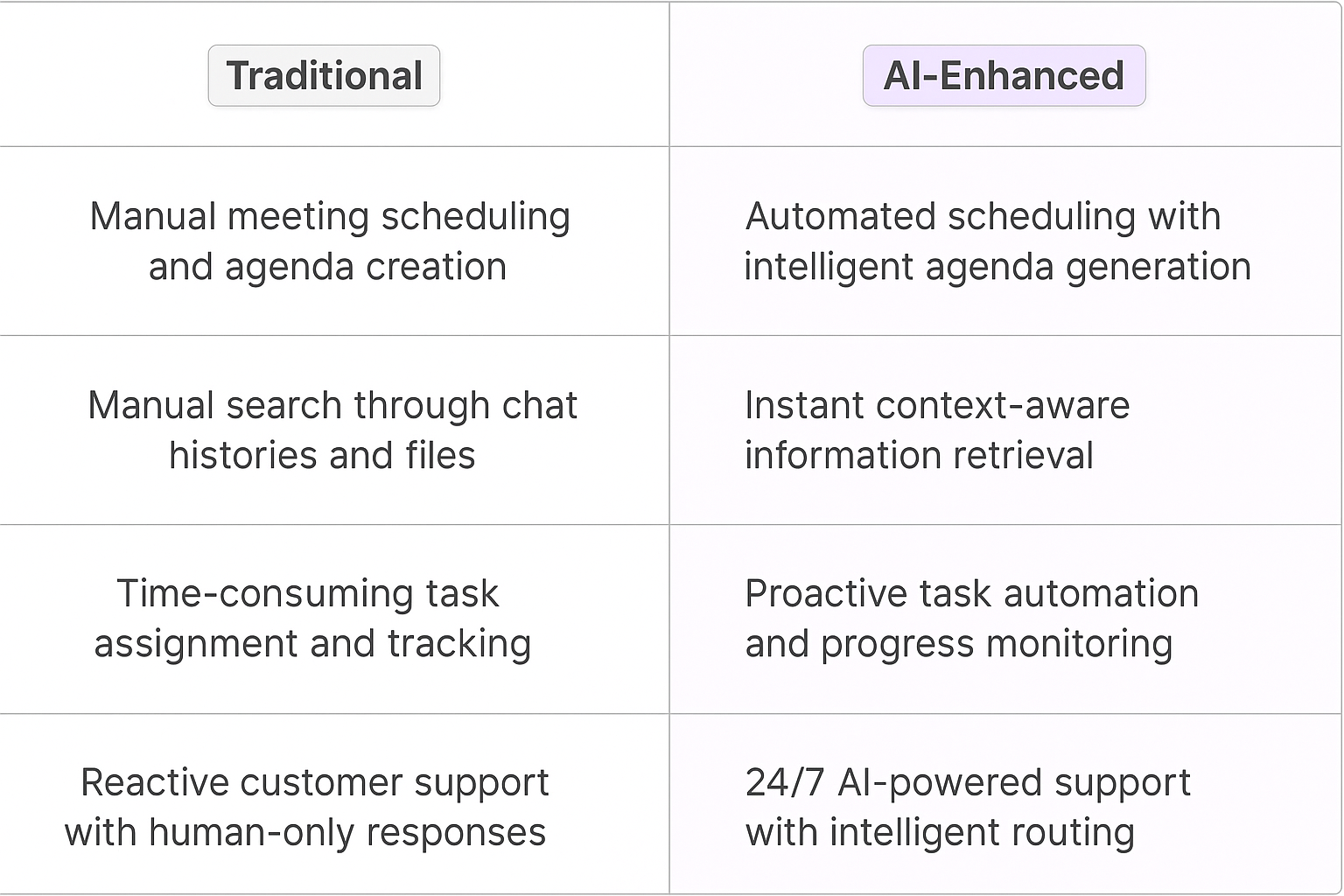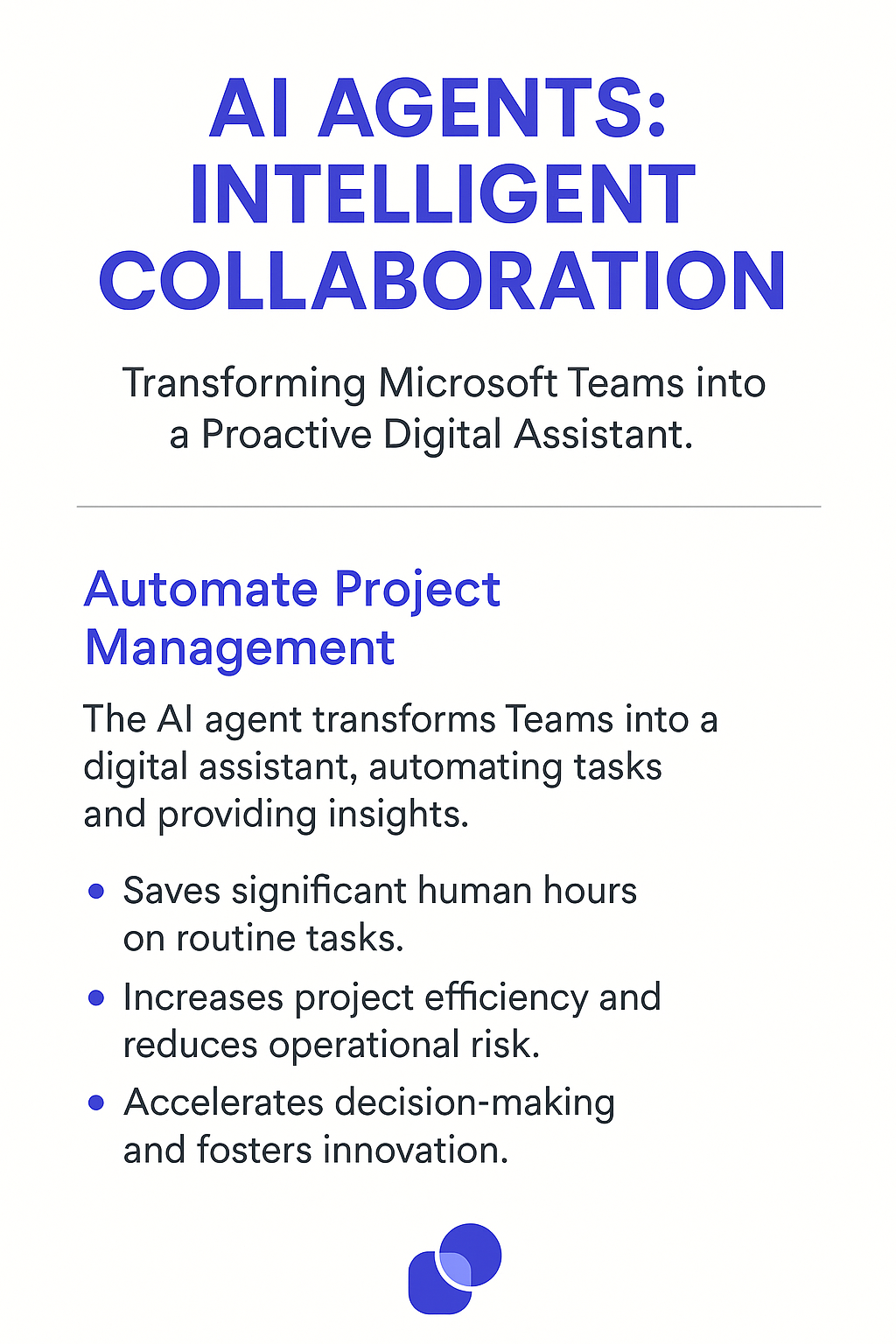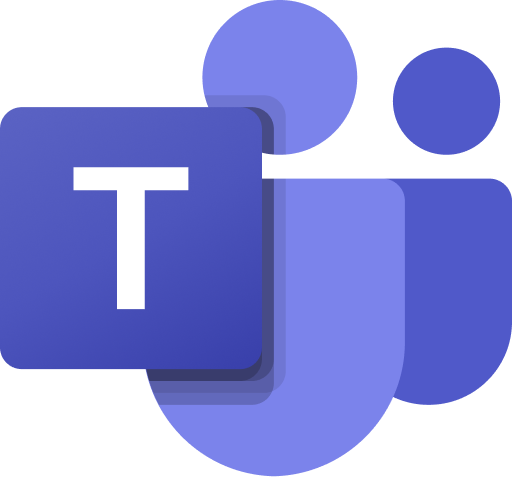Microsoft Teams AI Agents
Understanding Microsoft Teams
What is Microsoft Teams?
Microsoft Teams is a cloud-based collaboration platform that's become the digital headquarters for many organizations. It's where conversations happen, files are shared, and projects come to life. But Teams isn't just about chat and video calls. It's a flexible ecosystem that can integrate various tools and services, including AI agents, to supercharge productivity.
Key Features of Microsoft Teams
Teams offers a robust set of features right out of the box. You've got your standard chat functionality, video conferencing, file sharing, and integration with other Microsoft 365 apps. But the real magic happens when you start leveraging its extensibility. Teams can host third-party apps and bots, turning it into a customizable workspace that adapts to your organization's unique needs. This is where AI agents come into play, taking Teams from a communication tool to a full-fledged digital assistant that can automate tasks, provide insights, and even make decisions.

Benefits of AI Agents for Microsoft Teams
What would have been used before AI Agents?
Before AI agents entered the scene, Microsoft Teams users were stuck in a world of manual tasks and endless searching. They'd spend hours digging through chat histories, scheduling meetings by hand, and trying to piece together information from various channels. It was like trying to solve a puzzle with half the pieces missing.
Teams relied heavily on human-powered help desks and IT support for even the most basic queries. Collaboration often meant long email threads or time-consuming meetings to get everyone on the same page. The cognitive load on employees was massive, with constant context-switching and information overload.
What are the benefits of AI Agents?
AI agents in Microsoft Teams are game-changers. They're not just tools; they're digital teammates that amplify human capabilities. These agents can parse through terabytes of conversation data in seconds, surfacing relevant information when you need it most. It's like having a photographic memory for your entire organization's knowledge base.
One of the killer features is context-aware task automation. AI agents can understand the flow of a conversation and proactively suggest next steps or even execute them. Imagine discussing a project deadline, and the agent automatically creates a calendar event and assigns tasks to team members. This level of ambient intelligence reduces cognitive load and lets humans focus on high-value work.
Natural language processing capabilities mean these agents can understand and respond to queries in human-like ways. They're not just search engines; they're conversational partners that can clarify, ask follow-up questions, and provide nuanced responses. This dramatically lowers the barrier to accessing information and getting help.
Perhaps most importantly, AI agents learn and improve over time. They adapt to your team's unique language, processes, and needs. It's like having a digital teammate that gets smarter with every interaction, continuously optimizing workflows and surfacing insights that humans might miss.
The network effects here are profound. As more teams adopt these agents, the collective intelligence of the system grows exponentially. We're moving towards a future where AI agents don't just assist individual teams but facilitate cross-functional collaboration at scale, breaking down silos and accelerating innovation.
In essence, AI agents in Microsoft Teams are ushering in a new era of augmented collaboration. They're not replacing humans; they're empowering us to work smarter, faster, and more creatively. This is the kind of technological leap that doesn't just increment productivity—it fundamentally reshapes how we think about teamwork and organizational knowledge.
Potential Use Cases of AI Agents with Microsoft Teams
Processes
AI agents in Microsoft Teams are game-changers for process optimization. They're not just fancy chatbots; they're digital teammates that can transform how teams operate. Take meeting management, for instance. These AI agents can automatically schedule, set agendas, and even draft follow-up notes. It's like having a hyper-efficient executive assistant embedded in your collaboration platform.
Another killer process use case is project management. AI agents can track deadlines, assign tasks, and provide real-time progress updates. They're constantly monitoring project channels, parsing conversations, and proactively flagging potential bottlenecks. This level of oversight used to require a full-time project manager, but now it's baked into the Teams environment.
Tasks
On the task level, AI agents in Microsoft Teams are absolute workhorses. They can handle data analysis tasks that would typically eat up hours of an analyst's time. Imagine dropping a spreadsheet into a Teams channel and asking the AI to summarize key trends or generate visualizations. It's like having a data scientist on speed dial, but without the hefty consulting fees.
Content creation is another area where these AI agents shine. They can draft emails, create presentation outlines, or even generate social media posts based on team discussions. It's not about replacing human creativity, but augmenting it. The AI can handle the heavy lifting of initial drafts, freeing up team members to focus on refining and adding that human touch.
Customer support is yet another task where AI agents in Teams can make a massive impact. They can field initial inquiries, route complex issues to the right team members, and even suggest solutions based on past interactions. It's like having a customer support expert who never sleeps and has perfect recall of every past interaction.
The beauty of these AI agents in Microsoft Teams is their ability to learn and adapt. They're not static tools, but evolving digital teammates that get smarter with each interaction. As they integrate more deeply into team workflows, they'll uncover efficiencies and insights that we can't even imagine yet. This isn't just an incremental improvement in productivity tools; it's a fundamental shift in how knowledge work gets done.

Industry Use Cases
AI agents in Microsoft Teams are reshaping how businesses operate across sectors. These digital teammates aren't just fancy chatbots; they're powerful tools that can transform entire workflows. Let's dive into some real-world scenarios where AI agents are making waves in different industries.
From healthcare to finance, these AI-powered allies are tackling complex tasks, freeing up human bandwidth for high-value work. They're not replacing humans, but rather augmenting our capabilities in ways that were once the stuff of sci-fi. As we explore these use cases, you'll see how AI agents are becoming indispensable partners in the modern workplace.
What's particularly exciting is how these AI agents are adapting to industry-specific needs. They're not one-size-fits-all solutions, but rather specialized tools that understand the nuances of each sector. This tailored approach is what's driving their adoption and impact across diverse fields.
So, let's roll up our sleeves and examine how AI agents in Microsoft Teams are revolutionizing workflows in various industries. These examples will give you a taste of the transformative potential these digital teammates hold.
Healthcare: Transforming Patient Care with Microsoft Teams AI Agents
The healthcare industry is ripe for AI-driven innovation, and Microsoft Teams AI Agents are poised to make a significant impact. Let's dive into how these digital teammates could reshape patient care and clinical workflows.
Consider a large hospital network struggling with patient follow-ups and appointment scheduling. Enter the Microsoft Teams AI Agent, a 24/7 digital health coordinator that integrates seamlessly into the existing Teams infrastructure.
This AI-powered teammate can analyze patient records, lab results, and appointment histories to proactively reach out to patients who need follow-up care. It drafts personalized messages, schedules appointments, and even initiates video calls for quick check-ins – all within the Teams platform that healthcare providers already use.
But here's where it gets really interesting: the AI Agent doesn't just handle administrative tasks. It can also assist in clinical decision-making. By analyzing vast amounts of medical literature and patient data, it can suggest potential diagnoses or treatment plans for doctors to consider.
Imagine a scenario where a doctor is puzzled by a patient's symptoms. They can quickly consult the AI Agent through Teams, which can instantly cross-reference the symptoms with millions of case studies and recent medical research. This real-time, AI-powered second opinion could be a game-changer in complex cases.
The potential for improving patient outcomes is enormous. With AI Agents handling routine tasks and providing data-driven insights, healthcare providers can focus more on direct patient care and complex medical challenges. It's not about replacing human expertise, but augmenting it with AI-powered tools that are always learning and improving.
This application of Microsoft Teams AI Agents in healthcare isn't just a minor improvement – it's a fundamental shift in how medical professionals can interact with data, make decisions, and care for patients. As these AI teammates continue to evolve, we might see a future where personalized, AI-assisted healthcare becomes the norm, leading to better outcomes and more efficient healthcare systems overall.
Finance: AI Agents Reshaping Investment Strategies on Microsoft Teams
The finance world is about to get a major upgrade. Microsoft Teams AI Agents are set to transform how investment firms operate, and it's not just about crunching numbers faster.
Think about a mid-sized hedge fund. They're drowning in data, trying to spot market trends before anyone else. Now, drop an AI Agent into their Microsoft Teams environment. This isn't just another chatbot – it's a digital quant analyst on steroids.
This AI teammate can sift through terabytes of financial data, news articles, and social media chatter in real-time. It's not just looking for obvious patterns; it's uncovering hidden correlations that human analysts might miss. When a potential opportunity or risk emerges, it pings the relevant team members directly in Teams.
But here's where it gets really interesting: The AI Agent doesn't just present data. It generates hypotheses, suggesting novel investment strategies based on its analysis. Imagine a trader getting a Teams notification: "Unusual activity detected in emerging market currencies. Potential arbitrage opportunity. Click for analysis and suggested trades."
The AI isn't making trades on its own – that would be a regulatory nightmare. Instead, it's augmenting human decision-making, providing insights and suggestions that the investment team can act on.
This AI teammate is also learning constantly. Every interaction, every decision made by the human team, feeds back into its models. Over time, it becomes an invaluable repository of institutional knowledge, accessible to everyone through Teams.
The implications are huge. Smaller firms could punch above their weight, leveraging AI to compete with the big players. Larger institutions could operate with unprecedented agility, reacting to market shifts in real-time.
We're not talking about AI replacing finance professionals. We're looking at a future where the most successful investors will be those who best know how to collaborate with their AI teammates. It's a symbiosis of human intuition and machine intelligence, all facilitated through the familiar interface of Microsoft Teams.
This is just the beginning. As these AI Agents evolve, we might see them taking on more complex roles – perhaps even participating in investment committee meetings, offering real-time analysis and alternative viewpoints. The finance industry is notoriously resistant to change, but this wave of AI-powered transformation might be too powerful to ignore.
The data analysis capabilities alone could revolutionize how investment decisions are made, turning every team member into a data-driven decision maker with AI-powered insights at their fingertips.

Considerations and Challenges for Microsoft Teams AI Agents
Implementing AI agents in Microsoft Teams isn't just a plug-and-play affair. It's a complex dance of technology, user experience, and organizational dynamics. Let's dive into the nitty-gritty of what you're really signing up for when you decide to bring these digital teammates into your Teams environment.
Technical Challenges
First off, integration isn't a walk in the park. You're dealing with Microsoft's ecosystem, which means navigating their API limitations and quirks. It's not uncommon to find yourself in a situation where the AI agent's capabilities don't quite mesh with Teams' native features.
Data privacy is another beast altogether. You're essentially inviting a third party into your company's digital living room. How do you ensure that sensitive information doesn't leak? It's not just about slapping on some encryption and calling it a day. You need robust data handling protocols that comply with regulations like GDPR or CCPA.
Then there's the issue of scalability. Sure, your AI agent might work smoothly with a team of 10, but what happens when you need to deploy it across an organization of 10,000? You're looking at potential bottlenecks in processing power and response times that could turn your productivity booster into a frustrating lag-fest.
Operational Challenges
On the operational front, user adoption is your first hurdle. You might think everyone will be thrilled to have a new digital teammate, but reality often begs to differ. There's always resistance to change, and if the AI agent isn't intuitive or doesn't provide immediate value, you'll find it gathering digital dust.
Training is another critical piece of the puzzle. Your team needs to understand not just how to use the AI agent, but also its limitations. There's a real risk of over-reliance or misuse if people don't grasp what the AI can and can't do.
Maintenance is the silent killer of many AI implementations. These aren't set-it-and-forget-it tools. They require constant fine-tuning, updates, and sometimes complete overhauls as your organization's needs evolve. Are you prepared for the ongoing investment in time and resources?
Lastly, there's the challenge of measuring ROI. It's easy to get caught up in the hype, but how do you quantify the value of these AI agents? You need clear metrics and KPIs from the get-go, or you risk investing in a shiny new toy with no tangible benefits.
Implementing AI agents in Microsoft Teams is a journey fraught with both promise and pitfalls. It's not for the faint of heart, but for those who navigate these challenges successfully, the payoff can be transformative. Just remember, the devil is in the details, and in this case, those details are numerous and complex.
Embracing the Future of Work with AI-Powered Collaboration
AI agents in Microsoft Teams aren't just another tech trend – they're a paradigm shift in how we approach collaborative work. These digital teammates are redefining productivity, breaking down information silos, and enabling a level of ambient intelligence that was previously unimaginable. As these AI agents continue to evolve, we're looking at a future where every team member has access to the collective knowledge and capabilities of the entire organization at their fingertips.
But let's be real – this isn't a plug-and-play solution. Implementing AI agents in Teams comes with its own set of challenges, from technical integration hurdles to the need for ongoing maintenance and user adoption strategies. Organizations that successfully navigate these challenges, however, stand to gain a significant competitive edge.
The key takeaway? AI agents in Microsoft Teams are not about replacing human workers – they're about augmenting human capabilities. They're freeing us from mundane tasks, surfacing insights we might have missed, and allowing us to focus on the high-value, creative work that truly drives innovation. As we move forward, the most successful teams won't just be using AI agents; they'll be mastering the art of human-AI collaboration. Welcome to the future of work – it's already here, and it's powered by AI agents in Microsoft Teams.











